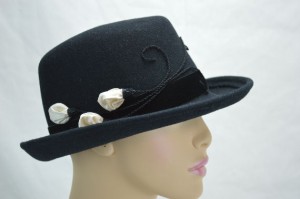The milliners’ world opened up to us when my husband and I started gathering millinery supplies. We both have been hat lovers since childhood; my husband with his fedora hats and me with any sort of cowboy hat I could find.
We first thought we would be true to real hat making by felting our own hat bodies- capellines, hoods, any sort of body that had a shape like Cousin It from The Addams Family- ready to be steamed and blocked.
Our attempts to felt merino roving in the dining room of our small San Francisco apartment was physically vigorous, fun to do together and, if we were great at it, maybe a possible small cottage business! We were hypnotized by the layering of the roving knowing that the simple berets were going to be beyond any French or Basque one we had ever seen. We followed directions, referred to the photos and, after much water, lots of soap suds and somehow felting red wool swirls into my best yoga pants, our hats were done. They were lumpy with lots of holes, pathetic looking and no one, including us, would ever wear one of these.
We decided that purchasing already felted hoods might be more practical and ordered from the vendors our millinery teacher in Redwood City recommended and purchased wool felt, fur felt and straw bodies to block our hats.
We acquired some hat blocks, both vintage and new. They are a bit pricey but can be found at antique shops, antique markets or on the internet. Once we blocked a hat, we were hooked. After blocking every which way I could on what blocks we had, I found I wanted more styles and felt quite limited with our small hat block collection.
Then my husband studied the ‘cowboy way’ of making hats which has lessened the need for us to have a specific style of block in that the forming of the crown is by ‘pinching’ the felt.
Once the hat is dry after being steamed, blocked and tied on the wood block dome, shellac is applied inside the crown to stiffen the felt. Once the felt is dry, steam again and style the crown top by ‘pinching’ and manipulating the crown. This has been a great discovery for us as we can now make traditional crowns of the fedora or cowboy styles or design our own just by forming the felt. Both the wool and fur felt are easily manipulated.
An avenue that I recently found to be most satisfying is refurbishing vintage hats. A client of mine had held onto a white fur felt (the shaggy fur felt which is hard to find these days) 1960’s cloche hat of her Grandmother’s that was too small. She let me take it apart, clean it with mild soap and water, stretch to size and redo it. Taking it apart was a great lesson for me in seeing the millinery techniques of 60 years ago. I took apart each piece from the hat in hopes that I could use the original pieces and I did. It turned out beautifully and my friend loves it because it fits now and it is still her Grandmother’s hat.
Blocking felted hat bodies, using the ‘Cowboy’ way, or refurbishing vintage hats, we love the process of making a hat that adorns someone’s head either to keep it warm or make them feel special wearing a hat as a wonderful accessory.
Gould Designs is a Santa Rosa based millinery arts business making women’s and men’s hats from felt or straw using traditional millinery techniques. The love of art for the head, touching textiles with history and learning something new every day are the pleasures of our hat making experience.
Contact info:
Gould Designs
Jessica Jones Gould and Scott Gould
Santa Rosa, CA 95403
Phone: 707 544 4192 Website: https://www.etsy.com/shop/


